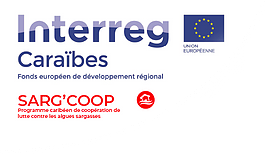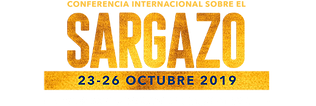Jueves 24 de octubre - Día 1
Estado del arte sobre el conocimiento del Sargazo
Miniconferencias 1
Conocimientos fundamentales sobre las algas sargazo y los microorganismos asociados
-
Basic knowledge on Sargassum and overview of the current results from the 2017 cruises
Dr Frédéric Ménard
Research director at the Research Institute for Development France
He conducts research on the functioning of marine ecosystems in the context of global change: ecology, predator-prey relationships, fisheries and biodiversity.
Since 2016, he has been leading two projects of the Ministry of Ecology on Sargassum.
-
In situ observations of diversity and distribution of Sargassum and associated fauna
Dr Amy Siuda
For over a decade, she has studied the distribution and diversity of pelagic Sargassum and its closely associated faunal community.
In 2015, Dr. Siuda and colleagues were the first to recognize that a previously rare Sargassum form was abundant in the equatorial Atlantic as well as in the newly episodic Caribbean inundation events
-
Fundametal knowledge on Sargassum on their associated microorganisms
Dr Pascal Jean Lopez
Directeur de Recherche au CNRS
Directeur de l’Observatoire Hommes-Milieux Littoral Caraïbe.
A microbiologist by training and holder of a doctoral thesis carried out at the École Normale Supérieure, he is now co-head of a research team at the Biology of Aquatic Organisms and Ecosystems Laboratory, which is located at the National History Museum Natural in Paris and also at the University of the Antilles.
-
Sargassum distribution and abundance reveal a World Heritage
Paulo Horta
Universidade Federal de Santa Catarina - Brésil
He is the head of the Brazilian sargassum network,
whose goal is to strengthen research and support for university programs
focused on solutions to environmental problems linked to this phenomenon.
Miniconferencias 2
Teledetección satelital, estimación de la superficie de sargazo en el mar Caribe
-
Prévisions d’échouement de sargasses sur les côtes françaises
Yves Gregoris
Directeur Interrégional Antilles-Guyane Météo-France
-
Assessing the Feasibility of Impact-Based Forecasting For Seasonal Influxes of Sargassum Seaweed on the Coastlines of Caribbean Small Island Developing States
Grahame Niles
Remote Sensing and GIS Specialist Caribbean Institute for Meteorology and Hydrology
Grahame Niles has been engaged as a Remote Sensing and Geographical Information Systems (GIS) specialist with the Caribbean Institute for Meteorology and Hydrology (CIMH) since 2014
-
Satellite-based early warning of Sargassum system within the Marine-Coastal Information and Analysis System
Dr Sergio Cerdeira Estrada
Estrada Subcoordinator de Monitero Marino Conabio, Mexico
-
Sargassum Watch from Space
Dr Chuanmin Hu
Professor of Oceanography University of South Florida, USA
Chuanmin Hu received a PhD degree in physics (environmental optics) from the University of Miami (Florida, USA) in 1997. He is currently a professor of optical oceanography at the University of South Florida (USA), who also directs the Optical Oceanography Lab of College of Marine Science.
-
ERISNet: Deep Neural Network for Sargassum detection along the coastline of the Mexican Caribbean
Javier Arellano-Verdejo Ph.D.
Member of the Academic Group of the Station for the Reception of Satellite Information ERIS-Chetumal El Colegio de la Frontera Sur, México
Javier is graduated from Engineering in Computer Systems. He obtained a master's degree in mechatronics and a Ph.D. in Computer Science.He is currently part of the academic group of the "Station for the reception of satellite information" ERIS Chetumal, where he has developed different software for the operation of the station and has created ERISNet.
-
Communicating Sargassum Forecasts
Hazel A. Oxenford
Professor of Marine Ecology and Fisheries CERMES, University of the West Indies, Cave Hill, Barbados
She is now well known regionally and internationally for her work in applied fisheries biology (especially flyingfish), coral reef ecology, and the impacts of climate change on marine ecosystems.
Presentación de los resultados de la convocatoria de proyectos (CDP) internacional Sargassum
-
CESAR Coastal Environment under Sargassum crisis
J.-R. Gros-Désormeaux, J.-P. Maréchal & V. David UMR8053, LC2S CNRS-UA
-
CORSAiR Atmospheric and marine CORrosions. Impact of chemical products from SARgassum decomposition and role of microorganisms on materials degradation. Phenomenological and legal considerations.
C. ROOS, L3MA, Université des Antilles
-
FORESEA: “FOREcasting seasonal Sargassum Events in the Atlantic”
Julien Jouanno, IRD-LEGOS
-
Sargassum Valorization by purolysis - application for food safety
Sarra Gaspard, Université des Antilles, Laboratory COVACHIMM2E
-
SargAs & CLD Environmental impacts of Sargassumleachates due to Arsenic and Chlordecone: quantification, mitigation and social perception
C. Mouvet, Brgm
-
Human health consequences of long term exposure to gaseous emissions produced by Sargassum seaweed decomposition
Pr. NEVIERE Remi Université des Antilles (UA) - CHU Martinique
-
Sargassum Origins Identity and origins of pelagic Sargassum
Thierry THIBAUT, Aix-Marseille University, MIO (Etienne BEZAULT, University of Antilles, BOREA)
-
SargScreen :International collaboration in research of the medicinal potentialities of the Caribbean Sargasso
Dr. Azaria Remion, ARVARNAM
-
SarTrib
Thierry CESAIRE, GTSI
-
Sargassum Agricultural Valorization and Energy production
Stéphane Pacaud, Centre R&D ENSAIA
-
Study of holopelagic SArgassum responsible of massive beachings: Valorization & Ecology on Caribbean coasts
Valérie STIGER-POUVREAU LEMAR UMR 6539 – IUEM - UBO
-
Ciencia y Tecnología ante las arribazones masivas de sargazo pelágico en México
Dra. Edith Calixto Consejo Nacional de Ciencia y Tecnología





